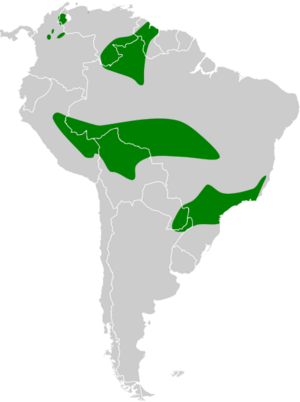Pavonine cuckoo facts for kids
Quick facts for kids Pavonine cuckoo |
|
|---|---|
 |
|
| Pavonine cuckoo at Piraju, São Paulo State, Brazil | |
| Conservation status | |
| Scientific classification | |
| Genus: |
Dromococcyx
|
| Species: |
pavoninus
|
 |
|
The pavonine cuckoo (Dromococcyx pavoninus) is a special type of cuckoo bird. It lives in the warm, tropical parts of the Americas. This bird has a long tail that gets shorter in steps, and a small crest on its head. It is one of only three kinds of cuckoos in its region that are known as brood parasites. This means they lay their eggs in other birds' nests!
Contents
What Does It Look Like?
The pavonine cuckoo has a rusty brown head and crest. The rest of its feathers are mostly dark brown on its back and lighter underneath. It has a rich, creamy-yellow stripe above its eye, and its throat and chest are also this color.
This cuckoo looks a bit like the pheasant cuckoo. However, the pavonine cuckoo is a bit bigger. It also has a slightly different call. The creamy-yellow parts on the pheasant cuckoo are paler. Plus, the pheasant cuckoo's throat and chest have dark spots, but the pavonine cuckoo's do not.
Where Does It Live?
The pavonine cuckoo lives in the lower parts of forests in South America. You can find it in wet lowland forests or wet mountain forests. It lives in many countries, including Argentina, Bolivia, Brazil, Colombia, Ecuador, French Guiana, Guyana, Paraguay, Peru, and Venezuela.
Even though it lives in a wide area, you might not find it everywhere. It tends to be in some places but not others, even where you might expect it to be.
How Does It Behave?
Not much is known about how this bird behaves. It is found in many places, but it is very shy and likes to hide. People hear its calls much more often than they actually see the bird. It seems to be a bird that prefers to be alone.
When it flies, it looks quite unusual. Its wings flap slowly, like a butterfly's. Its tail spreads out, and its wings pause briefly when they are at the very top of their beat.
Reproduction: Brood Parasitism
The pavonine cuckoo is a brood parasite. This is a rare way for birds to reproduce in the Amazon rainforest. Instead of building its own nest, the female cuckoo lays her eggs in the nests of other bird species. Some of the birds it uses as hosts include the drab-breasted bamboo tyrant, ochre-faced tody-flycatcher, eared pygmy tyrant, and plain antvireo.
Just like other parasitic cuckoos, the host birds take care of the cuckoo's eggs and young. The female cuckoo lays only one egg in each nest she parasitizes. Unlike some other cuckoos, her eggs do not look very similar to the host's eggs. When the cuckoo chick hatches, it pushes out any host chicks or eggs from the nest. The young cuckoo stays in the host's nest for about 24 days after hatching.
What Does It Eat?
We don't know a lot about what the pavonine cuckoo eats. However, its diet mainly consists of insects, especially orthoptera (like grasshoppers and crickets). It is usually seen on the ground or in the lower parts of the forest. This is probably where it hunts for its insect meals.
Is It in Danger?
The pavonine cuckoo is listed by the IUCN (International Union for Conservation of Nature) as being of "Least Concern". This means it is not considered to be in danger right now. No specific threats have been found for this bird. It lives across a large area and is thought to have a big population. While its numbers might be slowly going down, it's not happening fast enough to put the bird in a more threatened group.


